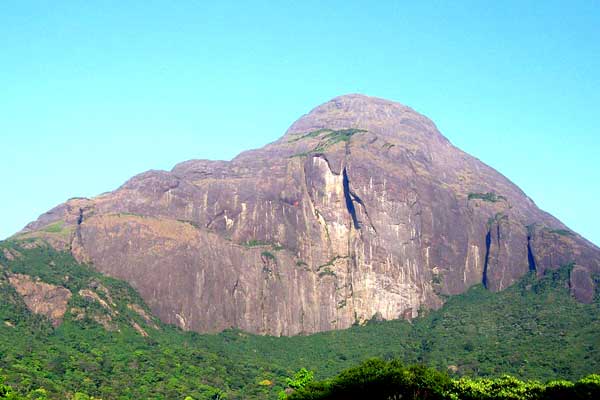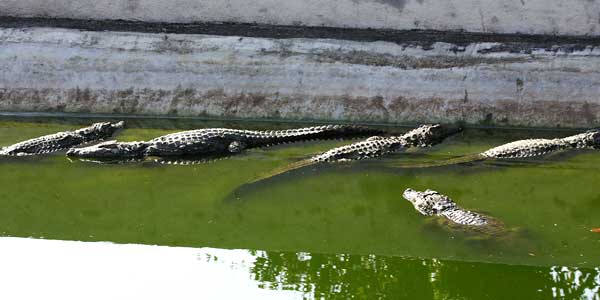 Established in 1997 the Agasthya Vanam biological park, is named after the magnificent Agasthyakoodam Peak looming at a distance. The park covers a total area of 23 sq km out of which 17.5 sq km are marked for natural regeneration, for the growth of vegetation and development of a thick jungle. The remaining area is to be used for manipulative programs of conservation. This project was constituted by the government of India after a scientific review committee recommended the setting up of a biological reserve in the highly degraded forest area know as the Kottor Reserve. This park has been set up for the regeneration, conservation, and propagation of a variety of wild animals, birds and plants. Though the area selected has negligible tree growth and wildlife, it has water sources in abundance and the soil is suitable for large-scale afforestation.
Established in 1997 the Agasthya Vanam biological park, is named after the magnificent Agasthyakoodam Peak looming at a distance. The park covers a total area of 23 sq km out of which 17.5 sq km are marked for natural regeneration, for the growth of vegetation and development of a thick jungle. The remaining area is to be used for manipulative programs of conservation. This project was constituted by the government of India after a scientific review committee recommended the setting up of a biological reserve in the highly degraded forest area know as the Kottor Reserve. This park has been set up for the regeneration, conservation, and propagation of a variety of wild animals, birds and plants. Though the area selected has negligible tree growth and wildlife, it has water sources in abundance and the soil is suitable for large-scale afforestation.
The sanctuary was set up in 1983 taking into account its diversity in ecological, faunal and floral content. The sanctuary has substantial natural vegetation cover ranging from subtropical forests to tropical evergreen forests. The sanctuary covers a total area of 53 sq km. The terrain is rugged with rushing streams, flat meadows, gentle to steep hills ranging from 90m to 1717m. The sanctuary is home to Elephants, tigers, wild boars, Nilgiri langur, gaur and palm squirrels
The Neyyar sanctuary is spread over the Southeast corner of the Western Ghats and covers a total area of 128 sq km. This is the drainage basin for the Neyyar River and its tributaries - Mullayar and Kallar. Although it was declared as a sanctuary in 1958, not much was done about wildlife conservation. Then in 1985, a separate wildlife wing was set up and as a result, conservation efforts have gathered momentum. This sanctuary has a substantial natural vegetation cover. The diversity of its flora makes the sanctuary an ideal gene pool preserve. The towering peak of Agastirmalai at an elevation of 1868m is a very prominent landmark.
 The mean summer temperature is around 35 degrees centigrade and the winter is around 16-degree centigrade. The average rainfall from the Southwest monsoon between May and July and the Northeast monsoon between October and November is about 3000mm. The tourist season here is between the months of November and March. The administrative complex of Neyyar complex Wildlife Sanctuary is about 1 km West of Neyyar Dam outside the sanctuary complex and has an information centre, a Crocodile farm, staff quarters, rest house, and a youth hostel. The sanctuary offers facilities for the tourists to visit the lion park and also boat on the Neyyar lake. Peppara is on the Western Ghats in the Nedumangad Taluk of Thiruvananthapuram district.
The mean summer temperature is around 35 degrees centigrade and the winter is around 16-degree centigrade. The average rainfall from the Southwest monsoon between May and July and the Northeast monsoon between October and November is about 3000mm. The tourist season here is between the months of November and March. The administrative complex of Neyyar complex Wildlife Sanctuary is about 1 km West of Neyyar Dam outside the sanctuary complex and has an information centre, a Crocodile farm, staff quarters, rest house, and a youth hostel. The sanctuary offers facilities for the tourists to visit the lion park and also boat on the Neyyar lake. Peppara is on the Western Ghats in the Nedumangad Taluk of Thiruvananthapuram district.
For More click here Thiruvananthapuram accommodation
For enquiries regarding entries to wildlife sanctuaries, contact :
The Chief Conservator of Forests(Wildlife)
Thiruvananthapuram, Kerala - 695014
The Wildlife Warden
Thiruvananthapuram Wildlife Division, Vattiyoorkavu P.O, Thiruvananthapuram
The Assistant Wildlife Warden
Neyyar Wildlife Sanctuary, Neyyar Dam P.O, Thiruvananthapuram District - 695576